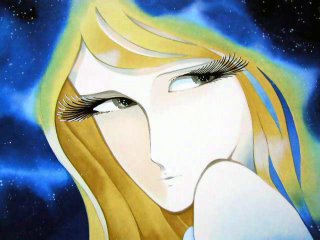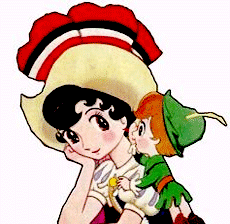Bonus - Interview with Michiko Ito, Part 1
Note: The audio overlapping problem has been fixed and a new version of the episode has been uploaded. If the audio overlaps in your copy, redownload the episode.This one's for all the Gerald acolytes out there, as he conducts an interview with Michiko Ito, professor of Japanese Studies at the University of Kansas. Tim Eldred, whom we interviewed in Show 14, is also present. Be sure to check out www.starblazers.com for Tim's Starblazers Rebirth and Tim's excellent documentary Space Battleship Yamato: The Making of an Anime Legend. Listen on, would-be otaku, and discover exactly what inanimate objects YOU should be praying to in order to guarantee that you see that next episode of Gundam!
Click Here to Download
2:25 – Michiko talks about anime in Japan when she was growing up, and that it was called “terebi manga.”
3:15 – What it is that separated Space Battleship Yamato from the rest of the anime on at the time, which was largely sports anime. When Michiko talks about "the end of each episode," she is referring to the number of days remaining until Earth is rendered uninhabitable, which added dramatic tension to the series. Michiko also talks about being fond of Starsha:
5:55 – Michiko explains that the competing program to Yamato was the Hayao Miyazaki classic Heidi of the Alps.
7:00 – Michiko and her brother call in to local radio stations to request the opening theme of Yamato, aptly named Uchuu Senkan Yamato, sung by Isao Sasaki.
8:10 – Chibi Maruko-chan is another powerhouse show in Japan. She also mentions that Yamato was able to widen the appeal of animated shows outside of the elementary school crowd; however, almost no merchandise for that audience was available.
10:50 – The Yamato radio specials, possibly the biggest promotional tease in history.
15:00 – Michiko explains how Yoshinobu "The Nish" Nishizaki wanted to portray the ideal man with his own ideals and his own goal as a major theme of Yamato.
18:35 – Michiko explain “Golden Time” to us, which is the equivalent of "Prime Time."
19:50 – Michiko explains her disappointment with continuing the Yamato franchise with sequels such as The Comet Empire after Saraba Uchuu Senkan Yamato - Ai no Senshitachi (aka Arrivederci Yamato) ended the series.
21:15 - Ribon no Kishi (aka Princess Knight) was the creation of Osamu Tezuka.
21:45 – Tokusatsu, the all-encompassing term for special effects shows. She also mentions the classic Kamen Rider and Kikaider. Michiko also mentions the very well known Candy Candy, a show that was so popular that episodes of it were made just for Italy. 
22:15 – At this point Gerald says "Kodai or Desslar." Kodai was the Japanese name for Derek Wildstar and Desslar was the Japanese name for Desslok. The big debate between female fans of the time was "who was the more popular character?" as each had fanclubs for their voice actors.
22:50 – VOTOMS, or Armored Trooper VOTOMS, the show Tim Eldred is nearly singlehandedly responsible for bringing to the English speaking world [Daryl: Neil Nadelman will have our heads for this outrage]. She also mentions Fang of the Sun Dougram, which was a prototype of sorts for VOTOMS as it was done by the same director and had the same atmosphere.
25:25 – Mobile Suit Gundam. Like this needs an explanation.
27:50 – Blue Noah, Nishizaki’s desperate attempt to recreate Yamato which failed miserably. And then, of course, there’s Odin. Just listen to Show #12 for more information than you ever wanted to know about that one.
29:10 – Saiyuki, also known as Journey to the West. The basis for tons of anime including Dragon Ball and--of course--Gensomaden Saiyuki. You can find out more about Journey to the West here.
30:45 – Michiko brings up the importance of “romance” in Yamato, also seen as a “otoko roman” or "men’s romance." Not to be confused with “shonen ai,” which Clarissa can tell us more about.
33:25 – Michiko is referring to the Americanized version of Uchuu Senkan Yamato known as Star Blazers, and she brings up Gojira also known as Godzilla.
34:30 – The joke that Gerald is referring to here occurred in the series where characters would appear in ships that would explode and they would instantly cut back to other characters that looked nothing like the guy in the ship that just exploded and say “just made it back in time,” to hide the fact that someone died.
40:25 – Japan’s Article 9
44:55 – Revenge of Mouflon
48:10 – Animentari Ketsudan and Zero-sen Hayato are some of the anime that depict war.
49:50 – Kamui Gaiden better known as The Legend of Kamui, by the legendary Sanpei Shirato. This is not related to the theatrical film Kamui no Ken (aka The Dagger of Kamui) that Daryl will be reviewing very soon.
54:35 - The Spiriting Away of Sen and Chihiro aka. Spirited Away.
55:40 – We haven’t been able to find this image that Tim says appeared on the cover of The New Yorker magazine. If anyone has it, email it to us so we can add it to the show notes.
58:45 – Chinmoku no Kantai aka. Silent Service by Kaiji Kawaguchi. Gerald mistakenly said “Kenji Kawaguchi.”
1:00:25 – Fax from Sarajevo
Next week, we have an actual show! Gerald does his review of the Kazuo Koike "jigoku manga" Lady Snowblood, Clarissa reviews Ghost in the Shell: Stand Alone Complex, and Daryl takes a look at the theatrical film Hokuto no Ken: Raoh Gaiden Junai-hen because he's not done watching Twelve Kingdoms yet.

0 Response to "Bonus - Interview with Michiko Ito, Part 1"
Post a Comment